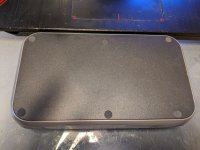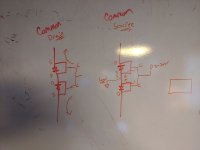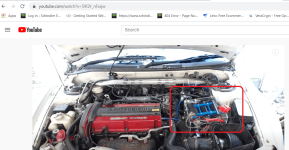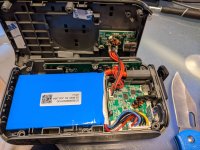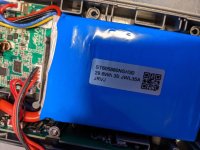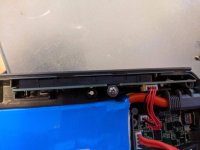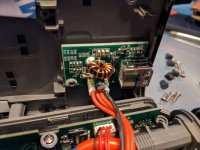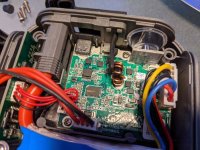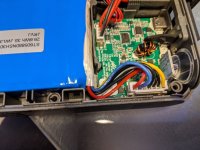methods
1 GW
I purchased 2pcs of the following item for around $50 and change from Costco Santa Cruz.

It rests in an "OFF" state and pressing the button brings an LCD screen to life that displays %charged.
Plug in to the uUSB (with anything) and it will begin to (very slowly) charge.
Hold the button down for a long time and the flashlight will illuminate or blink.
Plug an Android into the USB-C and it will charge an Android
Plug an old Apple laptop into the USB-C and it WILL indicate charging on that laptop (Even tho voltages dont match)
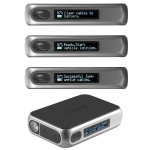
For Jumping, it walks you thru it and knows when it is done. We are about to see... if it looks for
* Dip
* Turns on
* Bump
* Turns off
I doubt it has a giant shunt. . . but it has two primary wires + a third
We could speculate for half an hour. . . or I could just crack it open and we will know exactly what it does.
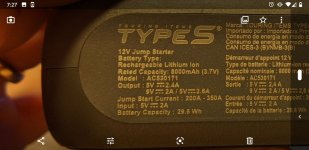
(Notice that I am compressing my pictures. I use IrfanView Batch Edit - which I tuned long ago to fit another forum)
Stated 8Ah (same as 8,000mAh)
Stated 3.6V
Stated 29.6Wh
29.6Wh / 8Ah = NominalVoltage
29.6Wh = NominalVoltage * 8Ah
29.6W = NominalVoltage * 8A
29.6/8 (W/A) = NominalVoltage
3.7 (V) = NominalVoltage = 3.7V
So.. that is just for one cell and not the whole pack.(?) If it were the whole pack we would now know the S configuration. We can still back that out several ways - for example - by assuming C rating and period of allowable ON time. (edit: more later)
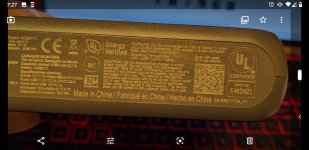
Plenty to go on there. . . and lots of Safety seals.
AC530171 brings us to the OEM website
https://typesauto.com/products/type-s-jump-starter-and-portable-power-bank-with-lcd-ac530171

OH DUDE - SPILLED THE BEANS!
I would have never even thought to look inside of that potted assembly for some active components. They even show us the package. . . so we know the basic Architecture.
Of note... the Battery housing has the UL approvals (presumably) and not the overall assembly. Eh hem. ... I dont see any approvals on the (non-potted) jump adapter (Which I will open in a second)
... Jumping was butter smooth and it lit off my old Honda with crusty terminals perfectly. It started beeping when it was done (not that you can hear that over an Engine...) and it displayed that it had used 3% of my 100% capacity (Which we will assume rolls off QUICK after the first couple of hits.
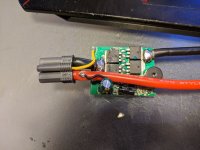
Oh yea, very standard setup.
Same I posted previously, so no kind of Intellectual Property or Secret
Power Comes in (and Leaves) Via the Drain of a pair of parallel mosfets.
Control circuit works off the middle, and I could reverse that high level in 15 minutes
Large Electrolytic (likely to survive Tjump?).... Have to draw it up to see.
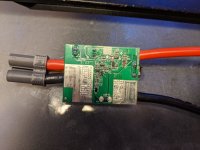
We can see that Battery (+) Voltage is tapped via a small gauge black wire.
We are breaking Battery (-) Voltage, so we have that ground signal.
We dont know what the yellow wire is ... but I doubt it is 5V in because feedback must be sent back...
5V for the onboard electronics could easily come from the battery connection.
(Putting my glasses on now, as this is more interesting than I anticipated... Original Unit was NO DOUBT potted...)

Reading the manual, posted above... Wow... Is that right? Just 30Wh for the whole thing???
... So they are marking the packaging in a WEIRD way unless they are up-boosting from 1S - which of course they are not... The only possible thing they could be doing is 3S
(Only Logical Conclusion)
3S gives you 9V to 12.6V
Either of those voltages, into a Starter short circuit, will push enough current to turn over a truck.
Going on that assumption (Which is Logical but may not be True)
10Ah per cell
Expect to see standard 2.6Ah 18650 inside
Backing out the C-Rate required to BURST
200 - 350A
Start with the 200A
Each cell in series sees this current
Each cell would be 2.6Ah
200A/2.6A = 77C
FAR from unheard of these days. Just yesterday I bought a bunch of Lipo from Hobby King rated from anywhere like 30C to 75C to 90C and above. ... So... Totally do-able, especially with a pouch right off the shelf...
And based on that logic, it cant be 18650's inside, it has to be an RC pouch*
... But Safety
For Safety (even with Temp sensors) it would MUCH more likely be a can with vents... but then... there are 8,000 laptops out there (oh, excuse me, 8 Million, er... I mean 8 BILLION) laptops out there running pouches.
Eh hem
(I love how we think we are on the brink of some new information in RC... while Laptops have been running pouches since the days of way back... taken apart MANY. . . know it to be true)
... so
I guess we have to take the primary housing apart. I doubt it will be sealed.
...
Final Guess?
* 3pcs 18650 high end?
* 3pcs Pouch low end?
... Based on the formfactor, and safety, I am guessing 18650...
BUT
350A / 2.6Ah = 135C
I dont think that burst rating exists. . .
BAH
I GIVE UP
WE WILL HAVE TO OPEN IT AND SEE
-methods

It rests in an "OFF" state and pressing the button brings an LCD screen to life that displays %charged.
Plug in to the uUSB (with anything) and it will begin to (very slowly) charge.
Hold the button down for a long time and the flashlight will illuminate or blink.
Plug an Android into the USB-C and it will charge an Android
Plug an old Apple laptop into the USB-C and it WILL indicate charging on that laptop (Even tho voltages dont match)

For Jumping, it walks you thru it and knows when it is done. We are about to see... if it looks for
* Dip
* Turns on
* Bump
* Turns off
I doubt it has a giant shunt. . . but it has two primary wires + a third
We could speculate for half an hour. . . or I could just crack it open and we will know exactly what it does.

(Notice that I am compressing my pictures. I use IrfanView Batch Edit - which I tuned long ago to fit another forum)
Stated 8Ah (same as 8,000mAh)
Stated 3.6V
Stated 29.6Wh
29.6Wh / 8Ah = NominalVoltage
29.6Wh = NominalVoltage * 8Ah
29.6W = NominalVoltage * 8A
29.6/8 (W/A) = NominalVoltage
3.7 (V) = NominalVoltage = 3.7V
So.. that is just for one cell and not the whole pack.(?) If it were the whole pack we would now know the S configuration. We can still back that out several ways - for example - by assuming C rating and period of allowable ON time. (edit: more later)

Plenty to go on there. . . and lots of Safety seals.
AC530171 brings us to the OEM website
https://typesauto.com/products/type-s-jump-starter-and-portable-power-bank-with-lcd-ac530171

OH DUDE - SPILLED THE BEANS!
I would have never even thought to look inside of that potted assembly for some active components. They even show us the package. . . so we know the basic Architecture.
Of note... the Battery housing has the UL approvals (presumably) and not the overall assembly. Eh hem. ... I dont see any approvals on the (non-potted) jump adapter (Which I will open in a second)
... Jumping was butter smooth and it lit off my old Honda with crusty terminals perfectly. It started beeping when it was done (not that you can hear that over an Engine...) and it displayed that it had used 3% of my 100% capacity (Which we will assume rolls off QUICK after the first couple of hits.

Oh yea, very standard setup.
Same I posted previously, so no kind of Intellectual Property or Secret
Power Comes in (and Leaves) Via the Drain of a pair of parallel mosfets.
Control circuit works off the middle, and I could reverse that high level in 15 minutes
Large Electrolytic (likely to survive Tjump?).... Have to draw it up to see.

We can see that Battery (+) Voltage is tapped via a small gauge black wire.
We are breaking Battery (-) Voltage, so we have that ground signal.
We dont know what the yellow wire is ... but I doubt it is 5V in because feedback must be sent back...
5V for the onboard electronics could easily come from the battery connection.
(Putting my glasses on now, as this is more interesting than I anticipated... Original Unit was NO DOUBT potted...)

Reading the manual, posted above... Wow... Is that right? Just 30Wh for the whole thing???
... So they are marking the packaging in a WEIRD way unless they are up-boosting from 1S - which of course they are not... The only possible thing they could be doing is 3S
(Only Logical Conclusion)
3S gives you 9V to 12.6V
Either of those voltages, into a Starter short circuit, will push enough current to turn over a truck.
Going on that assumption (Which is Logical but may not be True)
10Ah per cell
Expect to see standard 2.6Ah 18650 inside
Backing out the C-Rate required to BURST
200 - 350A
Start with the 200A
Each cell in series sees this current
Each cell would be 2.6Ah
200A/2.6A = 77C
FAR from unheard of these days. Just yesterday I bought a bunch of Lipo from Hobby King rated from anywhere like 30C to 75C to 90C and above. ... So... Totally do-able, especially with a pouch right off the shelf...
And based on that logic, it cant be 18650's inside, it has to be an RC pouch*
... But Safety
For Safety (even with Temp sensors) it would MUCH more likely be a can with vents... but then... there are 8,000 laptops out there (oh, excuse me, 8 Million, er... I mean 8 BILLION) laptops out there running pouches.
Eh hem
(I love how we think we are on the brink of some new information in RC... while Laptops have been running pouches since the days of way back... taken apart MANY. . . know it to be true)
... so
I guess we have to take the primary housing apart. I doubt it will be sealed.
...
Final Guess?
* 3pcs 18650 high end?
* 3pcs Pouch low end?
... Based on the formfactor, and safety, I am guessing 18650...
BUT
350A / 2.6Ah = 135C
I dont think that burst rating exists. . .
BAH
I GIVE UP
WE WILL HAVE TO OPEN IT AND SEE
-methods


